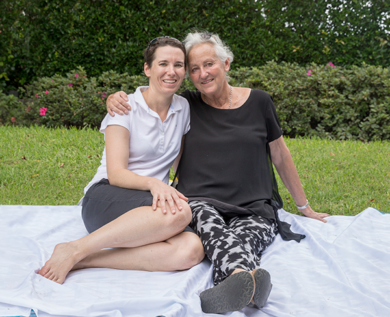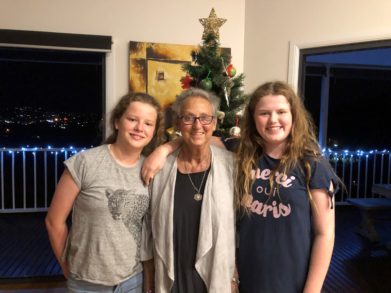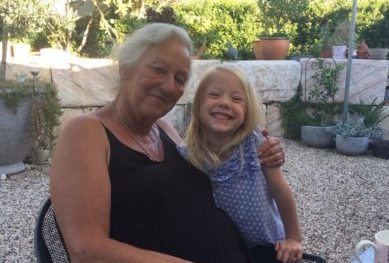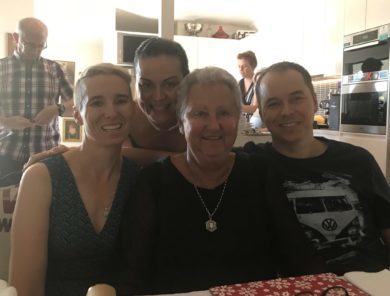“It’s an ongoing journey you’ve got to manage”
Cath Armstrong felt “absolute relief” to be diagnosed with amyloidosis in February 2017 because it meant she finally knew what she was dealing with… and it wasn’t all in her head!
Looking back, she believes she’d had amyloidosis for the previous three years; it just hadn’t been diagnosed.

In 2014, she’d spent a week in a Brisbane hospital having tests to find the cause of a range of symptoms – pain up the side of her face, weight loss (12kg in a month) and problems with her digestive tract.
“They couldn’t find out what was wrong and gave me sedatives. I think they thought it was a nervous disorder,” said Cath, 63, who lives at Tamworth (NSW).
“That’s fairly common with amyloidosis if you read about it. People sometimes do one or two stints in a mental health unit before finding out it’s not in their head… there’s actually something physically wrong with them,” she said.
Cath was “out of action” for nearly four months when she couldn’t drive or work, and it took her a long time to recover – over 18 months. She was initially treated by a neurologist for a nerve condition called trigeminal neuralgia. She then saw a musculoskeletal therapist who was also a cranialsacral therapist.
“I had to be very careful what I ate and could only eat really small meals. I didn’t know why but thought I could be gluten intolerant,” said Cath.
A gastroenterologist who did an endoscopy saw evidence that she had stomach ulcers that were healing.
“They didn’t run the Congo red test on the biopsies that is required for a diagnosis of amyloidosis, so didn’t pick up that’s what I had,” said Cath.
Then, in late-2016, she got “really sick” again in the lead-up to Christmas. A bookkeeper, Cath was working as PA for a developer, “doing all the paperwork for 46 residential blocks”. It was challenging and she was under a lot of pressure.
“Normally I don’t have any trouble operating under pressure, but it was too much with my system being unwell,” said Cath.
“I knew there was something wrong, but I didn’t know what it was and because I couldn’t get any answers, I just tried to manage it myself.”
Cath had severe weight loss again, along with bleeding from the bowel and ongoing problems with her digestive tract.
Her GP recommended another endoscopy, but her earliest opportunity to have the procedure in Tamworth was a couple of months later, in February 2017.
She also had a colonoscopy and this time biopsies from both investigations revealed amyloidosis.
“The gastroenterologist did 34 biopsies and every single one was positive to amyloidosis,” said Cath.
“He didn’t know what he was looking for and when he saw me, he said ‘this is not what I was expecting to find’.
“He said, ‘do you know what myeloma is?’ and I said ‘yes’. My sister-in-law had it and had passed away 10 years previously. Then he said, ‘well, amyloidosis is similar’.”
Cath was referred to a haematologist in Tamworth who had a special interest in myeloma and amyloidosis.
“He did a bone marrow biopsy and aspiration and gave the definitive diagnosis of AL amyloidosis, and myeloma as well! Then he ran through the treatment options, saying ‘think about what you want to do’,” said Cath.
“I made the decision pretty quickly because I went away and did a heap of research.”
She started treatment on the CyBorD regimen – cyclophosphamide, bortezomib and dexamethasone, the initial goal being to lower her lambda and kappa light chain ratio readings as much as possible. At that stage they were so high and she wasn’t suitable for an autologous stem cell transplant (SCT) but later that year she was put forward as a candidate for a SCT.

“I wanted to have the transplant in Brisbane because all my family were up there,” said Cath who has three adult children and seven grandchildren.
“It’s really important to have a good network around you. All my kids had different roles in supporting me when I got my diagnosis.
“My eldest girl [Belinda] used to fly down to Tamworth and see me. My second daughter [Rebecca] took time off – 2½ months – when I had the transplant, and my son [Matthew] would come down to see me and filled in if my daughter couldn’t come to the hospital.
“I had somebody there just about every day.”

In November 2017, Cath went to Brisbane for lead-up tests prior to her stem cell harvest, but during the gastroscopy, she “aspirated on the table”, and her children were told she ‘probably wouldn’t make it’.
Cath pulled through and recovered in ICU. But plans for the transplant were delayed. First, she needed two heart stents, but because her lungs were “burnt” from the aspiration and she had a “terrible cough”, she had to wait for her lungs to recover.
In January 2018, Cath’s stem cells were harvested but they didn’t get enough stem cells, so she had a second harvest the following month, and the Leukaemia Foundation helped out with accommodation in Brisbane.
Her transplant was in March. She was hospitalised for seven weeks during and after the transplant and went home to Tamworth in May.
Cath described the transplant as “reasonably successful”.
“The light chain numbers went down to virtually normal. My lambda light chains, which had been really high (about 320 at diagnosis) came down to 20-something (after the transplant).
“One of the problems was my kidneys. They had a lot of trouble recovering after the transplant and even now my kidney function is compromised.
“For a short time after the transplant I didn’t have any chemo, but then the light chain numbers started going up again, so I went back on maintenance chemo – thalidomide and two other drugs.
“That bopped along okay,” said Cath, but the drugs affected her cognitively.
“You’re not as sharp as normal, so number crunching was at times quite challenging. I had the advantage of working from home. If I didn’t feel well, I could have a rest and work later into the evening.

“I never really stopped working,” said Cathy, but she didn’t work much for two months during the transplant.
Then, at the end of the 2019 financial year, she gave up bookwork for the time being when she got “a nasty dose of shingles”. The nerves in her bladder were affected and she had a suprapubic catheter for four months.
This coincided with starting a new drug, lenalidomide, her fifth variation in treatment since her diagnosis.
“It’s expensive because it’s not on the PBS – $6000 a month,” said Cath, who was “very fortunate” to access the drug on compassionate grounds because she had myeloma as well.
She was on lenalidomide until the end of November 2019 when her immune system “had a bit of a crash and burn”.
“My platelets got down to 30; the normal range is 150-400,” she said.
In January (2020), Cath went back on lenalidomide at a reduced dose – one tablet every three days – and when she spoke to Amyloidosis News, she had just found out her immune system was starting to recover.
“My platelets were up to 130 today,” she said.
In mid-2019, Cath decided it was “a bit confusing” to have two haematologists – one in Brisbane, with a team of six or seven specialists including a nephrologist and cardiologist, and one at Tamworth.
“Now I’m just running with the team in Brisbane, where they all work together, which certainly isn’t available in Tamworth,” said Cath, who flies to Brisbane for her four-weekly reviews.
“Usually for a couple of days, before getting the okay to go home. Sometimes I’ve had to stay for up to 2½ weeks to do more blood tests, while they try and figure out what they are going to do with me!
Cath’s approach to managing amyloidosis
“You’ve got to learn to not have too many expectations about anything, to go with the flow and remember that amyloidosis is a disease you’ve got to manage, like diabetes.
“It’s all relative. I read this case today about a guy in the States with exactly the same as me; AL amyloidosis and myeloma and he had a SCT. He was in his early-30s and a personal trainer. He ended up having a heart transplant because his amyloidosis was in the heart and it also went to the kidneys and he had a kidney transplant. Then the myeloma kicked in and his spine started to crumble, so he had two steel rods put in his back. So I think you’ve got to keep it all in perspective and say, ‘this story doesn’t sound too bad does it’?”
“I just deal with things as they arise. I take it as it comes,” said Cath who describes herself as “a bit of a problem solver”.
“If something doesn’t work, I go to plan B, and if that doesn’t work, I go to C, D and E. You’ve just got to have that sort of attitude, not to be negative, and to look for solutions all the time.”
Cath doesn’t have a bucket list.
“You realise after something like this that all of that is irrelevant. What’s most important is family. I network with my friends and have friends stay and I enjoy myself.
“A lot of people probably don’t realise it takes a lot of effort to cope with this illness. It’s ongoing management, and I still get tired,” said Cath.
Her days revolve around daily physio exercises, visiting a physio once a week, exercise classes, regularly seeing her local GP for “other bits of treatment’’, injections to keep her bones strong and post-transplant immunisations.
“My goals now are eliminating as much stress as possible, physically to keep building in strength, and catching up with family and friends,” she said.
Cath’s advice based on her experience
“My advice is to seek help and, if you possibly can, to be well supported by family, and keep them informed. Whoever your support network is, take them on the journey, don’t block them out. You’ve got to include them if you want them to help you. This is a terminal disease, so we have to deal with it together.
“When I was in hospital, and they didn’t think I was going to make it, one of the doctors said to me, ‘you know, not many people of your age (early-60s) come in with power of attorney done, so their kids can do things and make decisions’.
“I did my power of attorney in the nine months when I was being prepared for the SCT, and I’ve since done an Advanced Health Care Directive and made it very clear what my wishes are.
“Don’t to be afraid to ask your specialists questions, even the basic terminology in a blood test. Ask them to explain things to you so you feel you can make an informed decision and you’ve got a clear understanding of what’s happening to you.
Last updated on August 6th, 2020
Developed by the Leukaemia Foundation in consultation with people living with a blood cancer, Leukaemia Foundation support staff, haematology nursing staff and/or Australian clinical haematologists. This content is provided for information purposes only and we urge you to always seek advice from a registered health care professional for diagnosis, treatment and answers to your medical questions, including the suitability of a particular therapy, service, product or treatment in your circumstances. The Leukaemia Foundation shall not bear any liability for any person relying on the materials contained on this website.